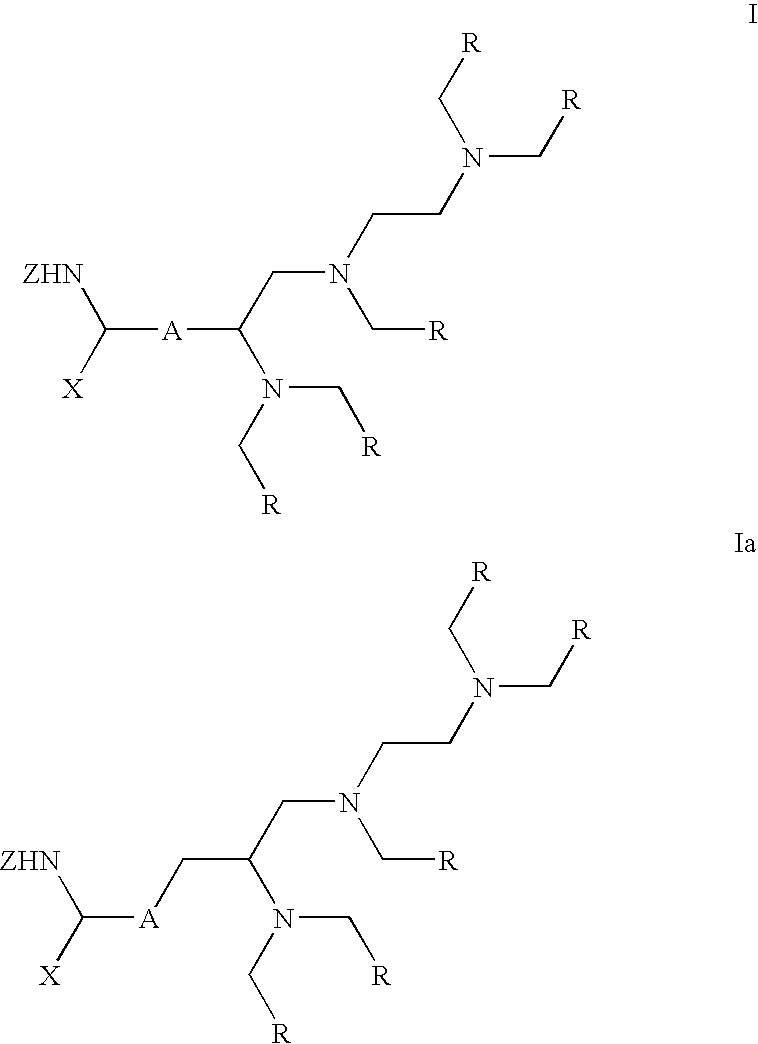Labeling reactant
a technology of diethylenetriaminepentaacetic acid and labeling, which is applied in the field of labeling reactants, can solve the problems of inability to prevent laborious purification procedures, inability to synthesize reactants which allow direct solid phase conjugation of oligopeptides, and difficulty in purification and characterization of desired biomolecule conjugates, etc., and achieves simple synthesis of building blocks and high efficacy. , the effect of large-scale synthesizing
- Summary
- Abstract
- Description
- Claims
- Application Information
AI Technical Summary
Benefits of technology
Problems solved by technology
Method used
Image
Examples
example 1
The synthesis of penta-tert-butyl 2-{4′-{2-[4-allyloxycarbonyl-4-(fluorenylmethyloxycarbonylamino)]butyrylamido}benzyl}-diethylenetriamine-pentakis(acetate), 2
[0037] Fmoc-Glu-OAII (1.31 g, 3.21 mmol), HATU (1.22 g, 1.32 mmol) and DIPEA (0.57 mL, 3.21 mmol) were dissolved in dry DMF (5 mL), and the mixture was stirred for 15 min at RT. Compound 1, disclosed in Corson, D. T., Meares, C. F., 2000, Bioconjugate Chem., 11, 292 (2.50 g, 3.21 mmol; predissolved in 2 mL of dry DMF) was added and the mixture was stirred for an additional 2 h. The mixture was diluted with dichloromethane (50 mL), washed twice with 10% citric acid and dried over Na2SO4. Purification on silica gel (eluent CH2Cl2 / MeOH 9:1, v / v) gave 2.84 g (82%) of compound 2.
[0038]1H NMR (CDCl3): δ 8.31 (2H, br s); 7.75 (2H, d, J 7.3); 7.61 (4H, m); 7.39 (2H, t, J 7.3); 7.30 (2H, m); 7.02 (2H, d, J 8.6); 5.96 (1H, m); 5.89 (1H, m); 5.26 (1H, m); 4.65 (2H, d, J 5.4); 4.41 (2H, m); 4.22 (1H, t, J 6.7); 3.40-2.38 (24H); 1.48 (36...
example 2
The synthesis of penta-tert-butyl 2-{4′-{2-[4-carboxy-4-(fluorenylmethyloxycarbonylamino)]butyrylamido}benzyl}diethylenetriamine-pentakis(acetate), 3
[0039] Compound 2 (1.00 g, 0.90 mmol) was dissolved in dry THF (20 mL) and deaerated with argon. Pd(Ph3P)4 (63 mg) and sodium sulfinate resin (1.0 g) were added, and the mixture was stirred for 2 h at RT. The resin was filtered off, washed with THF and the filtrate was concentrated. The residue was dissolved in dichloromethane, washed with 10% citric acid, dried over 4Å molecular sieves. Concentration in vacuo yielded compound 3. ESI-TOF-MS for C61H88N5O15(M+H)+: calcd, 1130.63; found, 1130.65.
example 3
The Synthesis of Oligopeptide Conjugates
[0040] A model sequence (RKEAASIKVAVS) was synthesized in 10 μmol scale using Fmoc chemistry and recommended protocols (coupling time 30 min for natural amino acid analogues, and 2 h for 3). One or five blocks 3 was coupled to its carboxy terminus. When the chain assembly was completed, the resin was treated with the mixture of crystalline phenol (75 mg), ethanedithiol (25 μL), thioanisole (50 μL), water (50 μL) and trifluoroacetic acid (1 mL) for 4 h. The resin was removed by filtration, and the solution was concentrated in vacuo. The crude oligopeptide was precipitated with diethyl ether. The precipitate was redissolved in water and treated with gadolinium(III) citrate (5 equiv per ligand). Purification was performed on HPLC.
PUM
| Property | Measurement | Unit |
|---|---|---|
| magnetic | aaaaa | aaaaa |
| imaging | aaaaa | aaaaa |
| MRI | aaaaa | aaaaa |
Abstract
Description
Claims
Application Information
 Login to View More
Login to View More - R&D
- Intellectual Property
- Life Sciences
- Materials
- Tech Scout
- Unparalleled Data Quality
- Higher Quality Content
- 60% Fewer Hallucinations
Browse by: Latest US Patents, China's latest patents, Technical Efficacy Thesaurus, Application Domain, Technology Topic, Popular Technical Reports.
© 2025 PatSnap. All rights reserved.Legal|Privacy policy|Modern Slavery Act Transparency Statement|Sitemap|About US| Contact US: help@patsnap.com



